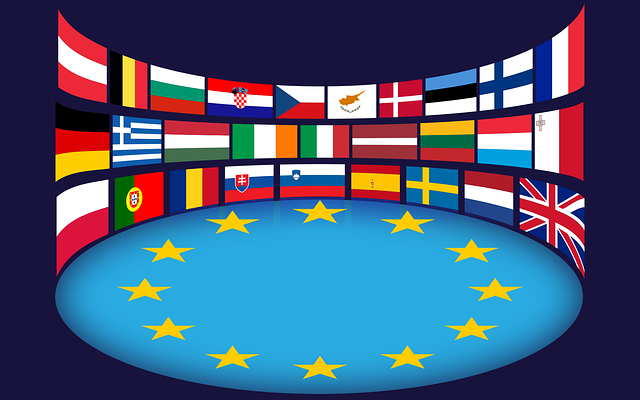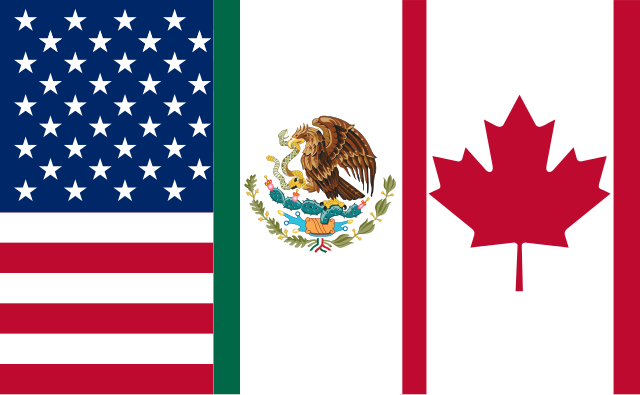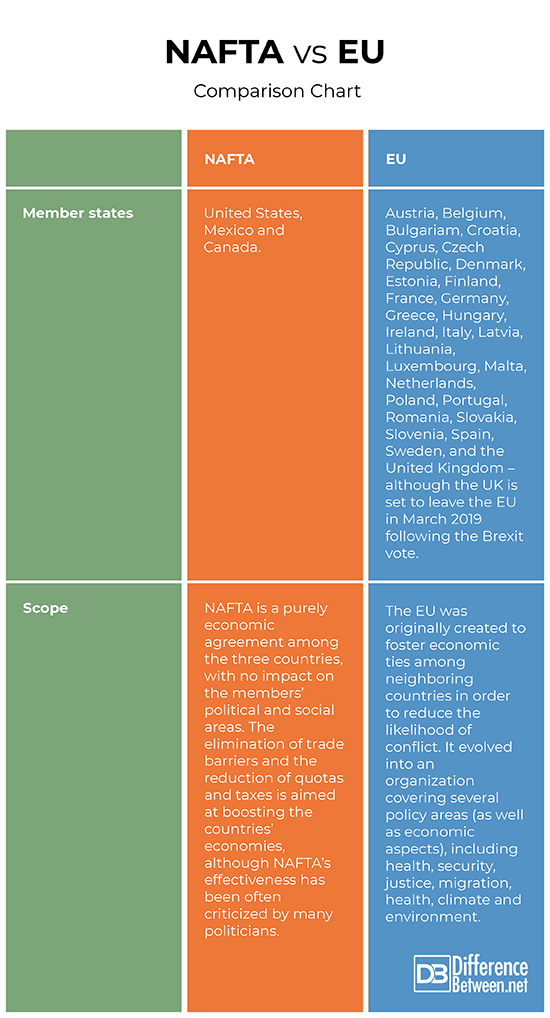Difference Between NAFTA and EU
The European Union (EU) is a unique political and economic union between 28 European countries, while the North America Free Trade Agreement (NAFTA) is a treaty between the United States, Mexico and Canada. NAFTA aims at eliminating trade barriers between the three countries involved, facilitating the movement of goods across borders, while the EU was originally created to foster economic cooperation among European countries after World War II. While the EU evolved into a complex organization – currently counting 28 member states – that covers policy and security areas (as well as key economic factors), NAFTA has remained a purely economic treaty, and has been re-negotiated after Trump became US President.
Although both aim at creating free trade zones and at fostering economic growth in key areas, EU and NAFTA are different in term of size, scope, reach and implementation. NAFTA’s main goal is eliminating barriers to trade and investment between Canada, Mexico and the United States, while the EU’s main goal is the creation of single European market through the creation and implementation of rules that apply to all member states – thus enabling the free movement of goods, people and capital.

What is the EU?
The process of creation of the European Union began in the aftermath of World War II to promote economic cooperation and create ties among countries in order to prevent conflict. The European Economic Community – the predecessor of the EU – was created in 1958. At the time, the only six member states were Belgium, Germany, France, Italy, Luxembourg and the Netherlands. The number of member countries continued to grow steadily during the years, as did the areas covered by the agreement. From a trade bloc created to promote economic ties among six countries, the EEC developed into a political and strategical alliance among 28 countries: the European Union, which was officially created in 1993. The EU has promoted peace and stability in Europe and the entire world, helped improve living standards in most parts of Europe and resulted in the creation of a single currency – the Euro – to further facilitate trade and free movement.
People and goods can move freely within the European Union as border controls have been abolished in most cases. People can travel without needing visas or permits, and living, studying and working abroad has become much simpler for EU citizens. According to the EU regulations, all EU countries must treat EU Citizens in the exact same way as their own citizens for employment and social security. The key goals of the European Union are:
- The enhancement of economic, political, territorial and social cohesion among member states;
- The promotion of peace and well-being;
- The promotion of security, freedom and justice;
- The elimination of social exclusion and discrimination;
- The enhancement of free movement of people, goods and capital;
- The creation of an economic monetary union (Euro); and
- The creation of a competitive economic market.

What is NAFTA?
The North America Free Trade Agreement (NAFTA) is a bilateral trade agreement between the United States, Mexico and Canada. It came into effect in January 1, 1994, superseding the existing Canada-United States Free Trade Agreement that had been in place since 1989. NAFTA was championed and promoted by former US President Bill Clinton, who added to key side agreements. The North American Agreement on Labor Cooperation (NAALC) and the North American Agreement on Environmental Cooperation (NAAEC) aim at preserving and protecting the environment as well as the rights of American workers, and were introduced in order to address concerns expressed by some members of the US Senate. NAFTA has been re-negotiated under Trump’s presidency, as the President argued that the US was not benefiting from the agreement as much as the other two countries were. Despite recent changes in the treaty, NAFTA includes provisions related to:
- Facilitation of trade among the four countries;
- Elimination of economic barriers;
- Rules of origin;
- Dispute settlement procedures;
- Promotion and protection of intellectual property rights;
- Customs law; and
- Government procurement.
NAFTA is a purely economic agreement among United States, Canada and Mexico, and while it contains provisions related to economic relationship, government procurement and customs procedures, it does not cover policy areas and does not aim at creating political, territorial and social cohesion among the three countries.
Similarities between NAFTA and EU
The North America Free Trade Agreement and the European Union have a number of aspects in common, as both were created to promote and enhance economic ties among a group of countries. Although they developed in different ways – with the EU having become a much broader alliance among most European countries – there are some aspects the two have in common:
- Both promote economic partnerships by eliminating trade barriers and facilitating the movement of goods and capital across borders;
- Both have developed from initial smaller agreements (the European Economic Community and the Canada-United States Free Trade Agreement respectively) to larger trade blocs, including more countries;
- Both aim at creating strong economic blocks among neighboring countries;
- Both have been criticized by member states. NAFTA has been often criticized by US President Trump, who started the re-negotiation of a number of provisions in order to maximize the US’ profit, while the EU is often criticized by nationalists and EU citizens who believe that the union is detrimental for the poorer economies in the Union; and
- Both have been challenged by separatist movements. President Trump has threatened to leave NAFTA if the treaty is not re-negotiated and the role of the US becomes more central, while the EU’s existence has been threatened by Brexit (the decision of the United Kingdom to leave the European Union, which will come into effect in March 2019) and by a growing wave of populist and nationalist movements in many countries (Germany, France, Italy, Austria, Hungary, etc.).
Difference between NAFTA and EU
The key difference between the North America Free Trade Agreement and the European Union is their scope. NAFTA remains a purely economic agreement among three countries, while the EU has developed into a political, social and territorial union between 28 countries. Other key differences between NAFTA and EU include:
- Freedom of movement: while both treaties aim at eliminating trade barriers among member states, the EU evolved into a political, territorial and social union, meaning that EU citizens are free to move from country to country with no (or very little) restrictions. Border controls have been eliminated among many EU countries, and people can move freely within the European Union. Conversely, while NAFTA facilitates the movement of goods among the US, Canada and Mexico, there are many restrictions related to the free movement of people, in particular between Mexico and the United States. US and Canada immigration policies are rather strict, and the creation of a territorial and political union in north America is unrealistic; and
- Currency: the EU resulted in the creation of a single currency, which has been adopted by most member countries, while each member of NAFTA maintained its own currency.
NAFTA vs EU: Comparison Chart

Summary of NAFTA vs EU
Bilateral and multilateral trade agreement have the ability to facilitate and promote trade among a group of countries while reducing the likelihood of conflict and war. NAFTA is a bilateral agreement between the United States, Canada and Mexico, which came into effect in 1994. Even though it has been recently re-negotiated and altered, it aims at reducing trade barriers among member countries in order to promote the emergence of an economic bloc.
Conversely, the EU is a more complex and unique economic and political union among 28 European countries. It was originally created to facilitate trade among a limited number of states, but later evolved in a political union. All member states adopted the same currency – the Euro – and goods, capital and people can move freely within the EU borders. NAFTA and EU differ in terms of scope, reach, size and implementation, as the first remains a purely economic agreement, while the latter has evolved into a territorial, social, political and economic union.
- Difference Between Michelle Obama and Melania - January 29, 2019
- Difference Between Trump and Modi - December 4, 2018
- Difference Between Carbon Tax And Cap And Trade - December 4, 2018
Search DifferenceBetween.net :
 Email This Post
: If you like this article or our site. Please spread the word. Share it with your friends/family.
Email This Post
: If you like this article or our site. Please spread the word. Share it with your friends/family.
2 Comments
Leave a Response
References :
[0]Image credit: https://pixabay.com/en/european-union-flags-stars-eu-1328256/
[1]Image credit: https://upload.wikimedia.org/wikipedia/commons/thumb/5/51/Flag_of_the_North_American_Free_Trade_Agreement_%28standard_version%29.svg/640px-Flag_of_the_North_American_Free_Trade_Agreement_%28standard_version%29.svg.png
[2]Cameron, Maxwell A., and Brian W. Tomlin. The making of NAFTA: How the deal was done. Cornell University Press, 2002.
[3]Galperin, Hernan. "Cultural industries policy in regional trade agreements: the cases of NAFTA, the European Union and MERCOSUR." Media, Culture & Society 21.5 (1999): 627-648.
[4]Nugent, Neill. The government and politics of the European Union. Palgrave, 2017.


I am Teknik Laborant from Kosovo i want to work with you for Euro nafta and 50 euro Thank you very much.
I AM AHEAD TEKNIK LABORANT AND I WANT THANK YOU.